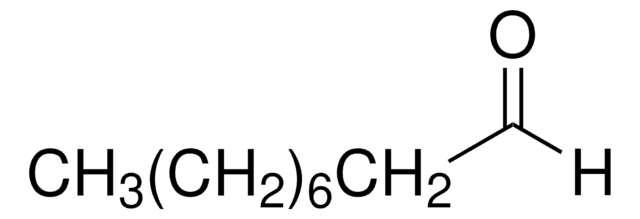08607
2-Ethyl-1-hexanol
analytical standard
Synonim(y):
Isooctyl alcohol
About This Item
klasa czystości
analytical standard
Poziom jakości
gęstość pary
4.49 (vs air)
ciśnienie pary
0.2 mmHg ( 20 °C)
Próba
≥99.5% (GC)
temp. samozapłonu
550 °F
okres trwałości
limited shelf life, expiry date on the label
granice wybuchowości
0.88 %, 104 °F
9.7 %, 113 °F
metody
HPLC: suitable
gas chromatography (GC): suitable
współczynnik refrakcji
n20/D 1.431 (lit.)
n20/D 1.431
tw
183-186 °C (lit.)
mp
−76 °C (lit.)
gęstość
0.833 g/mL at 25 °C (lit.)
Zastosowanie
cleaning products
cosmetics
environmental
flavors and fragrances
food and beverages
personal care
ciąg SMILES
CCCCC(CC)CO
InChI
1S/C8H18O/c1-3-5-6-8(4-2)7-9/h8-9H,3-7H2,1-2H3
Klucz InChI
YIWUKEYIRIRTPP-UHFFFAOYSA-N
Szukasz podobnych produktów? Odwiedź Przewodnik dotyczący porównywania produktów
Opis ogólny
Zastosowanie
Hasło ostrzegawcze
Warning
Zwroty wskazujące rodzaj zagrożenia
Zwroty wskazujące środki ostrożności
Klasyfikacja zagrożeń
Acute Tox. 4 Inhalation - Eye Irrit. 2 - Skin Irrit. 2 - STOT SE 3
Organy docelowe
Respiratory system
Kod klasy składowania
10 - Combustible liquids
Klasa zagrożenia wodnego (WGK)
WGK 1
Temperatura zapłonu (°F)
167.0 °F - closed cup
Temperatura zapłonu (°C)
75 °C - closed cup
Środki ochrony indywidualnej
Eyeshields, Faceshields, Gloves, type ABEK (EN14387) respirator filter
Choose from one of the most recent versions:
Masz już ten produkt?
Dokumenty związane z niedawno zakupionymi produktami zostały zamieszczone w Bibliotece dokumentów.
Klienci oglądali również te produkty
Nasz zespół naukowców ma doświadczenie we wszystkich obszarach badań, w tym w naukach przyrodniczych, materiałoznawstwie, syntezie chemicznej, chromatografii, analityce i wielu innych dziedzinach.
Skontaktuj się z zespołem ds. pomocy technicznej




